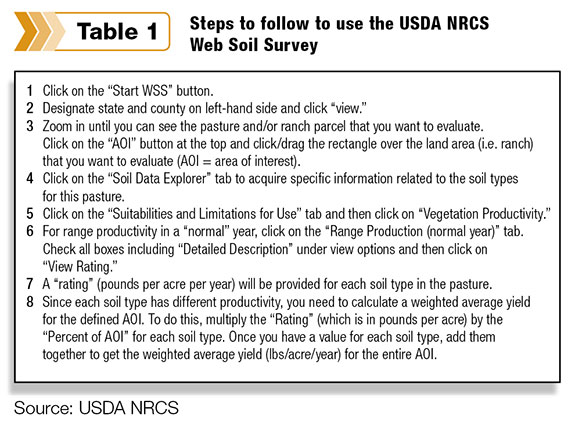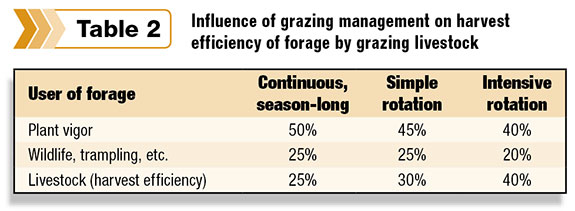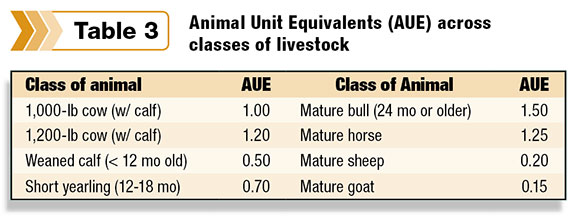To achieve profitability, producers must closely evaluate how efficiently forages are used by their cows, including during the grazing season.
Overgrazing will significantly reduce animal performance and can cause long-term damage to a forage base via reduced yield in future years.
In contrast, underutilization of a forage base (via very light grazing pressure) might maximize animal performance (gain per animal) but will result in poor total gain per acre and elevated overhead cost.
Some argue that stocking rate – the number of animals per acre of land over a period of time – is the predominant driver of profitability on many cattle operations.
Thus, it is crucial that operations properly balance forage supply with forage demand needed by their cow herd.
A few simple steps can be taken to determine carrying capacity and to compare forage supply with demand.
1. Estimate forage supply
Unfortunately, forage yield per acre can be highly variable year-to-year, due mostly to variation in the amount of precipitation.
Further, soil type can alter forage yield as well. Historical knowledge of an operation can help to determine likely forage yield per acre, including past stocking rates, but it can be inaccurate at times.
Unfortunately, the most accurate method of determining annual forage yield is via the very time-consuming and labor-intensive process of hand clipping and weighing forages from pastures. This is impractical on most operations.

A quicker (but much more crude) method of predicting forage yield is by using estimates available through the USDA based on soil survey data.
The USDA’s NRCS Web Soil Survey provides a reliable estimate of forage productivity for land all across the U.S., see (Table 1).
The yield data provided by NRCS is for all forage produced during an entire year.
Unfortunately, cattle aren’t able to consume 100 percent of the forage available in a pasture.
Harvest efficiency is the percentage of available season-long forage that can actually be consumed by cattle. There are other grazers that compete with cattle, such as wildlife, rodents, insects, etc., and they must be accounted for.
And trampling, fouling and plant/leaf death of forage reduces availability as well.
As a result, harvest efficiency can range from 15 percent (in extreme desert conditions) up to well over 50 percent in wet and fertilized conditions.

Typically, harvest efficiency on most operations will be 25 to 30 percent if continuous season-long or simple rotation grazing management is used (Table 2).
Let’s assume we have a 1,000-acre operation that has an average annual yield of 2,500 pounds of forage per acre based on NRCS data.
And the operation uses a simple rotation grazing system in order to have 30 percent harvest efficiency.
Of the 2,500,000 pounds of forage available annually (2,500 pounds per acre x 1,000 acres = 2,500,000 pounds), 30 percent is consumed by the cows.
This equals 750,000 pounds of forage that is available per year on the operation.
2. Estimate forage demand by the cow herd
Since forage demand is typically affected by an animal’s bodyweight, a common “base” must be used to determine animal demand for forage.
This base is the animal unit (AU) system in which feed intake is defined on the basis of a standard animal: a 1,000-pound cow.
It is assumed that a 1,000-pound cow consumes 2.6 percent of her bodyweight in feed daily (on a dry matter basis).
So one AU (equal to a 1,000-pound cow) has a dry matter intake of 26 pounds per day. Thus, during each month of grazing, the one AU consumes 780 pounds of dry feed (30 days x 26 pounds per day), which equals one animal unit month (AUM).

To get a sense of what one AU is equal to, below are some equivalents to enable forage needs to be compared across different animals (Table 3).
The general rule of thumb is that 100 pounds of bodyweight equals 0.1 AUE (animal unit equivalent). Thus, a 1,200-pound cow = 1.2 AUE.
Let’s go back to the 1,000-acre ranch in the example above that produces 750,000 pounds of forage per year.
This amount can be converted to an AUM basis by dividing total forage available by 780 pounds (the amount one AU consumes during one month). Thus, 750,000 / 780 = 961.5 AUMs.
And let’s assume we are grazing 100 cows, 15 replacement heifers and four bulls on the 1,000-acre ranch from May 15 to November 15 (six months).
And we think these cows weigh 1,200 pounds. The AUM calculations for forage demand are:
100 cows x 1.2 AU x 6 months = 720 AUM
4 bulls x 1.5 AU x 6 months = 36 AUM
5 replacement heifers x 0.7 AU x 6 months = 63 AUM
Total AUMs needed = 819 AUM
In this example, there is an excess of approximately 142.5 AUMs that will go unused during the year (961.5 AUM supply – 819 AUM demand).
This is equivalent to the amount of feed that 19 cows would consume during a six-month grazing period (142.5 AUM / 6 months / 1.2 AUE).
The immediate conclusion of this calculation indicates that this ranch is slightly understocked; there is more feed available for grazing than there are cattle to consume it.
However, it is crucial to realize several things, including the fact that all calculations are based on estimates including forage yield (which is based on soil survey data, precipitation, etc.), harvest efficiency, average cow weight, etc.
In reality, this calculation does not allow carrying capacity to be fine-tuned to a very specific number of animals. Rather, it simply enables a producer to determine if his operation is considerably understocked or overstocked.
In a sense, it provides the “guard rails” for deciding on how many cows to run, impact of increasing harvest efficiency, the number of cows to increase or decrease due to high or low precipitation, etc.
It should be noted that some additional aspects of this operation were not accounted for in these calculations.
For instance, in grazing cattle, the distance to water and amount of slope present can both contribute significantly to harvest efficiency.
Slopes greater than 10 to 15 percent can drastically reduce grazing, and cattle will often not travel more than two miles to water.
Ultimately, it’s important to maximize animal performance without damaging the forage resource base over time.
Calculating an operation’s carrying capacity should be done annually to account for predicted fluctuations in forage availability and to improve overall profitability. ![]()
PHOTO
Grazing operations should properly balance forage supply with forage demand needed by their cow herd. Photo courtesy of Progressive Cattleman staff.
Associate Professor
Beef Management Systems
Colorado State University









